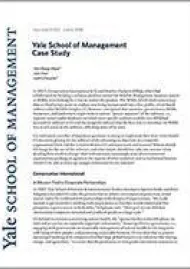TIAA-CREF

Connie Weaver joined TIAA-CREF in May of 2010 as executive vice president, chief marketing and communications officer. In this role, she was to oversee the company’s marketing, brand management, advertising, market research and analytics, corporate communications, and digital strategy functions. Before coming to the company, Weaver had held senior marketing positions at companies such as The Hartford, BearingPoint, and AT&T.
Weaver was assuming the marketing position of TIAA-CREF at a time when the company had undergone substantial changes in structure and attitude. In office for two years, TIAA-CREF’s CEO Roger Ferguson had led the company through finishing the initiatives his predecessor had identified during the Decisions 2003 strategic review as well as a major cost-cutting effort. Most importantly, Ferguson had led the company through the depths of a global recession. During these challenging economic times, TIAA-CREF’s conservative approach to investments had proven better suited to securing individual futures than those of many of its peers, and the company had gained as customers had made a “flight to security.”
Ferguson now set the company’s sights on achieving new goals. TIAA-CREF had added financial products that went beyond those that secured retirements, including money management products for saving for college and home ownership. Ferguson wanted these products that now accounted for about 15 percent of TIAA-CREF’s assets to make up a larger share of the company’s offerings. Ferguson also wanted to expand beyond the company’s traditional markets in higher education to include other nonprofits and government-supported organizations.
To accomplish these goals, Weaver needed to consider a number of questions. First, she had to assess the company’s efforts to restructure as part of Decisions 2003. What opportunities and challenges did the company’s open architecture, offices, new wealth management function, and segmentation schemes offer? How did this new distribution system fit with the company’s next goals?
Then Weaver had to consider TIAA-CREF’s awareness and positioning among customers. The company was competing against industry giants such as Fidelity and was not known to many customers (especially younger ones), even in its core market of higher education. Weaver wondered how to position the company to increase overall awareness and then to let people know that TIAA-CREF could serve more than just their retirement needs. What channels would be most effective?
Finally, Weaver had to work to educate customers about the advantages of TIAA-CREF’s offerings. During the recession, customers appreciated TIAA-CREF’s stability, but as equity markets began edging higher, many customers eyed the higher returns of risky funds and other esoteric offerings. Many of TIAA-CREF’s products, such as annuities, seemed stodgy by comparison, especially to customers intent on making back what they had lost during the downturn. TIAA-CREF had to convince not only end customers, but also third-party advisors who often urged their clients to get into these investments without regard to the risks they posed.